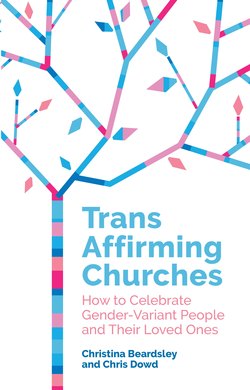Читать книгу Trans Affirming Churches - Chris Dowd - Страница 7
На сайте Литреса книга снята с продажи.
ОглавлениеIntroduction
We’re so glad that you have picked up this book and hope that you will read it. What you find in its pages is important because it is about the lives, loves and humanity of other people. We invite you to approach what we have to say with respect, and without too much prejudgement. Our subject is how to ensure that your church or fellowship is inclusive of trans people.
This book is aimed primarily at the leadership, both lay and clergy, of any local church. It is difficult to cover every ‘base’ as church culture varies from tradition to tradition, location to location. We have written from an inclusive Catholic Anglican outlook and a ‘middle of the road’ United Reformed Church perspective, as these are our experience. We have attempted to consider both Catholic and more conservative viewpoints where possible. The book does assume a small amount of prior knowledge and is not designed to be a ‘trans 101’ book but rather a discussion of how to include trans people in your church.
Its second readership is all those interested in including people in your church. This may simply be that you are interested as a point of justice or you have been impacted by the gender journey of a friend or loved one. We’ve tried to keep things general enough that the book is of value to you as well.
This is our third collaborative writing project about trans people and the Church. Chris was a contributor to This Is My Body: Hearing the Theology of Transgender People (2016) which Tina co-edited with Michelle O’Brien. In 2018 we co-authored Transfaith: A Transgender Pastoral Resource, based on Chris’s doctoral research into the spirituality of twelve transgender Christians. Rather than merely rephrasing what we have written before we have tried to cover new ground. For example, we have not included a glossary of trans terminology in this book because it already exists within Transfaith. While we briefly touch on Natural Law, a whole chapter of Transfaith is dedicated to that. We will signpost this earlier work as you progress through the book.
We are both ordained ministers, Tina in the Church of England and Chris in the United Reformed Church, with decades of experience of pastoral ministry between us. We are both practical theologians committed to evidence-based methods – including interviews and narratives and engagement with the medical/therapeutic consensus – in dialogue with theology, especially the insights and practical wisdom of Scripture and the Christian tradition. Tina transitioned in 2001 and has been both advocate and activist for the full inclusion of trans people in the Church. Chris approached his doctoral research into trans people’s spiritual journeys as a minister wanting to know more about how best to support trans people, and he has gone on learning.
Ideally, you will have already taken appropriate steps to include gender-variant people in your church and are reading this book to check that you are on the right lines. On the other hand, you may feel that you are only at the starting line as far as welcoming and affirming trans people is concerned. Or perhaps you consider yourself somewhere in between these two positions. Whatever your starting point, we believe that this book will be able to provide you with insights, guidance and resources on how to include trans people in your community. Our confidence lies in our evidence-based approach.
We have spent time listening to trans people and their loved ones to ensure that what is written here is grounded in their perceptions, needs and ideas of what you can do to make your church trans-friendly. We explain our methods later in this Introduction. The changes envisaged are not that radical. Indeed, what we suggest in this book will benefit your church and make it more inclusive for everyone.
One of the barriers to understanding trans people is that their differences – ‘our’ differences in Tina’s case, so we’ll use the first-person plural in this paragraph – are so often emphasised, rather than the humanity and faith we share with other Christians. We are rendered ‘other’ by medical language, by the media, and sometimes, sadly, by unhelpful ‘church teaching’. Our lives are often exoticised, eroticised and stigmatised. Some of us ‘blend in’; others do not, and ‘standing out’ can be dangerous. As a community we experience a high degree of social exclusion and minority stress – the chronic stress levels stigmatised minority groups can experience, due to interpersonal prejudice and discrimination, or poor social support and low socioeconomic status. We can be on the receiving end of violence and verbal, non-verbal and emotional abuse. The press is often intrusive and keen to tell our stories as they see them, rather than in our words and from our perspective. The reality of our experience and our very identity is questioned, publicly debated and even rubbished.
That’s a long, and by no means comprehensive, list of negatives. Negativity and controversy on that scale might be making you nervous and wondering whether you really want to enter the fray. Please stick with us though. This book is designed to guide you through the maze of misinformation and hyperbole. It is an opportunity to learn. In any case, the Church is meant to be, and often is, a place of love, for trans people, as for everyone else, and what we outline should build on and be congruent with what you are already doing.
